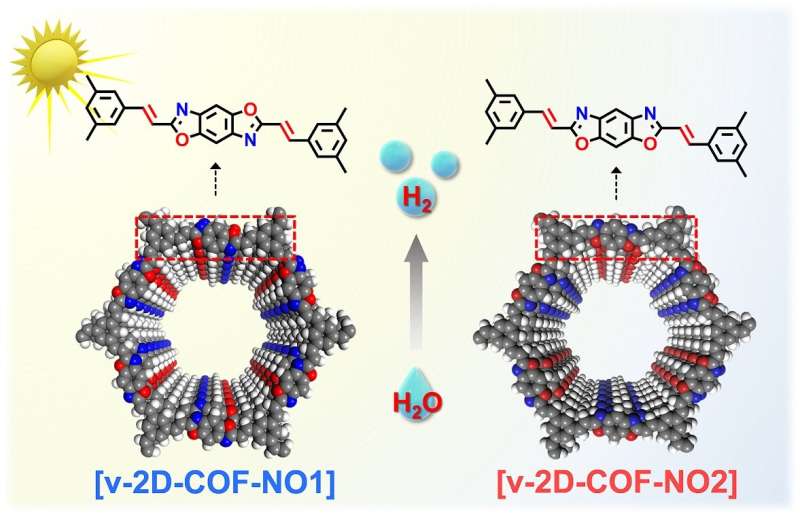Novel isomeric vinylene-linked covalent organic frameworks developed with distinct photocatalytic properties

Researchers led by Prof. Zahng Tao at the Ningbo Institute of Materials Technology and Engineering (NIMTE) of the Chinese Academy of Sciences has synthesized two novel vinylene-linked two-dimensional covalent organic frameworks (v-2D-COFs) with isomeric structures via benzobisoxazole-mediated aldol polycondensation, showing distinct photocatalytic properties. The study was published in Journal of the American Chemical Society.
Thanks to their excellent in-plane conjugation and high chemical stability, v-2D-COFs have attracted increasing interest and thus emerged as advanced semiconducting materials. However, exploring new synthesis approaches and delving into the physical and chemical properties of v-2D-COFs remain challenging, due to the limited chemical reactions and monomers applied in v-2D-COFs.
To address this issue, the researchers proposed a solid-state benzobisoxazole-mediated aldol polycondensation reaction. Based on this innovative reaction, two novel isomeric benzobisoxazole-bridged v-2D-COFs (v-2D-COF-NO1 and v-2D-COF-NO2) with trans/cis configurations for benzobisoxazole linkages were constructed.
The two synthesized isomeric v-2D-COFs showed similar crystalline structures in terms of molecular formulas, unit cells, and pore sizes. Nevertheless, they exhibit evident differences in optoelectronic and electrochemical properties, such as light absorption and emission and charge-transfer properties, according to the results of the ultraviolet-visible (UV-vis) absorption spectra and ultraviolet photoelectron spectroscopy.
Specifically, under AM 1.5G (solar irradiation standard spectrum) irradiation at -0.3 V vs reversible hydrogen electrode, the v-2D-COF-NO1 with trans-benzobisoxazole showed better photoelectrochemical performance than v-2D-COF-NO2.
Employing Pt as cocatalysts, the v-2D-COF-NO1 showed excellent photocatalytic hydrogen evolution rate, twice the value of v-2D-COF-NO2.
This study provides a novel approach of benzobisoxazole-mediated aldol polycondensation to enrich the family of v-2D-COFs, and sheds light on the isomerization-mediated photocatalytic properties of v-2D-COFs.
More information: Shengxu Li et al, Direct Construction of Isomeric Benzobisoxazole–Vinylene-Linked Covalent Organic Frameworks with Distinct Photocatalytic Properties, Journal of the American Chemical Society (2022). DOI: 10.1021/jacs.2c06042
Journal information: Journal of the American Chemical Society
Provided by Chinese Academy of Sciences


















